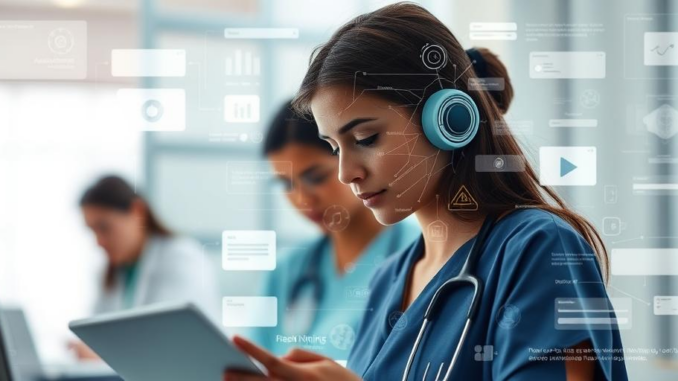
Summary
Deepgram’s Nova-3 Medical is transforming healthcare transcription with unparalleled accuracy. It boasts a 63.7% improvement in Word Error Rate (WER) over competitors, ensuring precise documentation and minimizing errors. This AI-powered model streamlines workflows, improves patient safety, and reduces costs.
Healthcare data growth can be overwhelming scale effortlessly with TrueNAS by Esdebe.
** Main Story**
Okay, so, the increasing reliance on tech like electronic health records (EHRs) and telemedicine means we’re dealing with a ton of digital info in healthcare, right? And that means we need really good transcription solutions. I mean, if the old speech-to-text models mess up medical terms, well, that can cause problems for patients. That’s where Deepgram’s Nova-3 Medical comes in; it’s supposed to use AI to really shake things up.
Accuracy is Key, Isn’t It?
Deepgram is saying Nova-3 Medical is setting a new bar for accuracy, boasting a median Word Error Rate (WER) of just 3.44%. Which, I’ve gotta say, is a huge improvement! I’m talking a 63.7% jump over their closest competitor. The idea is that, with that kind of accuracy, there’s way less need for someone to go in and manually fix everything. It can really speed things up and lower the chances of errors. And what about the jargon?! I’m told that it’s much improved at catching tricky medical terms, with a 40.35% improvement in Keyterm Error Rate (KER) compared to competitors. That’s a big deal for making sure drug names and procedures are recorded correctly, isn’t it?
Think about it, you don’t want a doctor accidentally prescribing the wrong thing because the transcription was off. I remember this one time when I was shadowing a physician, the audio recording software misheard a drug name and nearly caused a major headache, you know what I mean?
Speed and Savings: A Double Win
But Nova-3 Medical isn’t just about being accurate; it’s also built for speed. They’re claiming it transcribes speech 5 to 40 times faster than other solutions. Imagine how useful that would be during a telemedicine consultation when time is of the essence. Plus, they’ve designed it to handle large volumes of transcription without slowing down, that’s a relief.
And then there’s the cost. Apparently, it’s more affordable than some of the big cloud providers, starting at $0.0043 per minute for pre-recorded audio and $0.0077 per minute for streaming audio. That’s money that healthcare tech companies can put back into improving their products. Which, let’s be honest, is always a good thing.
Customization and Security? Absolutely
Now, here’s where it gets really interesting. Nova-3 Medical is supposed to offer customization options, so developers can tweak the model for different medical specialties. Their Keyterm Prompting feature lets you optimize for up to 100 key terms without going through a full retraining process. So, you can really fine-tune it for those niche applications. Of course, security is a huge priority, and they’re saying it adheres to HIPAA regulations to protect patient data, good to know. They offer on-premises and virtual private cloud setups, too, so you can choose what works best for your organization.
The Big Picture
Overall, it seems like Deepgram’s Nova-3 Medical could really change the game for healthcare documentation. If it lives up to the hype. With improved accuracy, real-time performance, and customization, it could empower developers to build some pretty cool voice AI apps that streamline clinical workflows and improve patient care. As healthcare becomes more digital, solutions like this are going to be crucial for improving efficiency and cutting costs. Ultimately, it’s about patient safety. I mean, from clinical documentation to therapeutic scribing, this tech promises more reliable medical transcription. And that’s a win-win for everyone involved. As of today, March 13, 2025, Nova-3 Medical represents the forefront of AI-powered healthcare transcription, giving us a glimpse into a future where AI helps healthcare pros provide better care. This info is current as of today and could change as the tech evolves, just so you know.


Wow, 63.7% improvement in Word Error Rate? My brain’s WER is probably closer to 63.7% *worse* after trying to decipher doctor’s handwriting. Maybe this tech can finally unlock the secrets of those prescriptions scribbled on napkins!
That’s hilarious! I totally agree; deciphering doctor’s handwriting sometimes feels like cracking a code. Hopefully, this tech can help make those ‘napkin prescriptions’ a thing of the past, leading to fewer errors and more accurate patient care. It may even save lives!
Editor: MedTechNews.Uk
Thank you to our Sponsor Esdebe
So, we’re trusting AI with medical transcriptions now? What happens when Nova-3 confuses “metatarsal” with “metastasis”? Asking for a friend who may or may not have suddenly developed a phantom pain.